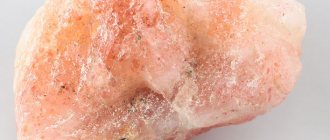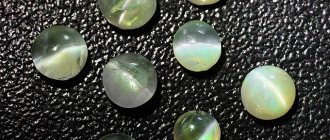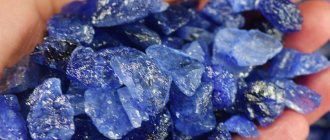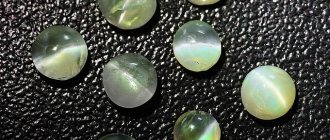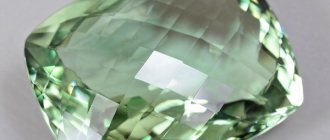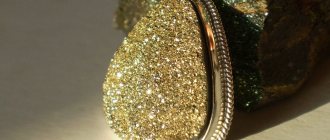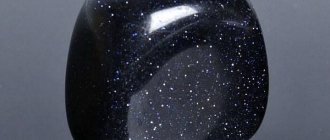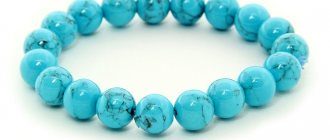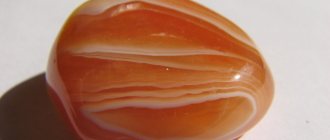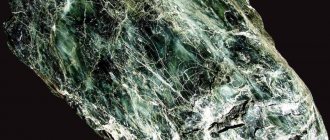| Formula | X2-3Si2O5(OH)4 |
| Color | Dark green, shades of black, brown |
| Shine | Glassy, greasy, waxy |
| Transparency | Opaque |
| Hardness | 2,5 — 4 |
| Cleavage | Absent |
| Kink | Conchoidal |
| Density | 2.2 - 2.9 g/cm³ |
The properties of the stone became part of the Ural legend. Craftsmen from Nikita Demidov's enterprises wove a tablecloth from a coil. After the feast, the owner, in front of Peter I, washed it and sent it to “dry” in the stove. The “snake” canvas remained intact.
Colors and varieties
Serpentine is an opaque mineral, sometimes it can be translucent. It has many varieties that differ in color, shade, pattern.
- Antigorite is a yellow or yellow-green mineral with a glassy luster, inexpensive.
Antigorite
- Bowenite is a translucent gem of light green or pale yellow color. Externally similar to jade.
Egg 48mm Bowenite
- Verdanite is a dark green swamp colored gemstone with black veins. Rich in magnesium.
Verdanite
- Vernantite is a deep green mineral with sparkles.
Vernantite
- Williamsite is a stone with a bluish sea tint, very expensive.
Williamsite
- Nigrescite - color ranges from dark green to black.
Nigrescite
- Ophiocalcite (serpentine marble) is a stone riddled with veins of calcite and dolomite.
Ophiocalcite
- Ophite is a somewhat translucent, uniformly green stone without inclusions.
Ophite
- Porcellophyte is an opaque gem, similar in appearance to porcelain.
Porcellophyte
- Retinolite is a dark orange or sand-colored mineral that casts black.
Retinolite
- Ricolite (poisonous serpentine) is a bright green gem, clearly striped.
Ricolite
- Satellite is a rare variety. An iridescent green mineral with a cat's eye pattern.
Satellite
- Ural (noble serpentine, mosswort) is a gem of pale olive or light green color. Has small black inclusions.
Ural coil
Like any stone, the coil is subjected to tumbling (processing), which emphasizes its external characteristics.
Tales of the Malachite Box
If you don't love beautiful stones with selfless love, skip this part. But we can’t help but say something about Bazhov, the singer of the Ural masters, the author of fairy tales.
The collection “Malachite Box” contains the working folklore of the Ural stone cutters, miners, and prospectors. The language in which the collection is written is rich and colorful. And so “ours” that they tried to translate the tales several times, but it didn’t work out very well. Problems in linguistics and culture. Try to translate the nicknames “Stuffy Goat”, “One and a Half Hari”, “Erasko Hurry” into any language. And with us, no matter the nickname, that’s the person’s character.
We recommend: ROCK CRYSTAL - icy breath of the earth
Yes, about the coil. There is also a story about him, “A Fragile Twig.” About a young master with golden hands and a keen heart. The Mistress of the Copper Mountain herself helped such people.
“Mityukha is sitting, grinding his berries from merchant’s material, and he himself is still thinking about the same thing: “What kind of cheap local stone can I make such a craft from?”
Suddenly some kind of either a woman’s or a girl’s hand stuck through the window, with a ring on her finger and in her sleeve, and placed a large slab of coil directly on Mityunka’s machine, and on it, like on a tray, was a travel juice.”
The Mistress of the Copper Mountain suggested to the master what could be made from waste material.
“Here I began to figure out which berry would be more suitable, and I myself stared at the place where the hand was. And then she appeared again and placed a burdock leaf on the machine, and on it were three berry branches, bird cherry, cherry and ripe, ripe gooseberries.” The master made a sprig of gooseberries, such that it could be confused with a real one.
Those who continue the work of the talented stone cutter live and create beauty from the simple serpentine stone. Souvenirs and crafts made from snake stone can be seen in jewelry stores. And almost everyone can buy a piece of the skin of the Great Snake.
Application
Serpentinite fountain in the Stockalper Palace
Due to their low hardness and good texture, serpentine stones have been used for centuries as an ornamental and decorative facing stone, and in rare cases for stone carving and cameo making. In Europe, serpentinites have been known as an ornamental stone for over 400 years and have been used to make countertops and apothecary vessels.
In Russia, serpentine has long been used for cladding interiors in palaces, in combination with other types of colored stones or metal - for the manufacture of stone-cutting products, as well as Florentine mosaics. In the royal suburban palaces of Russia - Gatchina and Pavlovsk - there were sets of artistic work, carved from coils, used in palace everyday life.
Carefully!
To avoid counterfeits, you should purchase jewelry made from coils only in jewelry stores. Craftsmen use exclusively high-quality stones with high density and rich colors for their work.
Serpentine also makes beautiful boxes, figurines and vases.
Place of Birth
Serpentine is most often mined in England, Hungary, Germany, India, Italy, New Zealand, the USA and Sweden.
In Russia, serpentine is mined in the Urals. At different fields, coils differ significantly in appearance. For example, the Malyshevsky or Chalinsky coil has mica inclusions, which make the mineral more alive; souvenirs are made from it.
And at the Shabrovskoye and Yuzhno-Shabrovskoye deposits, located in the Chkalovsky region, 20–25 km south of Yekaterinburg, Shabrovsky serpentine is mined. Having a rich green with white stripes, which is most often used as a facing material.
Serpentine jewelry
Products made from coil
When choosing jewelry, you should pay attention to the frame of this gem. The best option is a combination of coil with cupronickel, silver and bronze.
It is believed that the interaction of the coil with these metals enhances its valuable properties.
It also goes well with rhodonite, copper, platinum and obsidian.
In addition, the type of decoration is also important. Rings and bracelets strengthen bones, beads cleanse the biofield of negative energy, and earrings relieve migraines.
History of the mineral
Interest in the mineral first appeared in Europe in the sixteenth century. The magical properties of the serpentine stone were not yet known. Craftsmen used the gem as an ornamental material. They made dishes, watches, tabletops from it, and decorated weapons with it. It looked luxurious and at the same time was quite affordable for the average city dweller or poor aristocrat.
The more the stone became fashionable, the more people learned about who the coil is suitable for - both as a material and simply as a talisman. For example, it was useful to pharmacists: retorts, mortars, and pestles for grinding medicines were made from it. At the same time, alchemists and occultists drew attention to its magical properties.
Serpentinite, of course, attracted not only Europeans. Archaeologists have found talismans with the mineral in the tombs of the Incas and Mayans. The artifacts were placed there long before they learned about the gem in Europe.
In the East, serpentine rings and bracelets were a substitute for jade and jadeite, which only rulers had the right to wear. Serpentinites remained mere mortals. There, in the Arab world and among the Jews, the first legends about the gem were invented.
For example, there is a story based on the biblical story of Adam and Eve. The ancestor of mankind tasted the fruit from the tree of the knowledge of good and evil and choked. A small piece of fruit fell to the ground and turned into a serpentine - a stone reminiscent of the Tempting Serpent and his meanness.
Interestingly, a snake is not always an evil and insidious creature. The ancient Slavs revered the snake, and even a symbol with a snake image has reached us. It was called the same as our stone - Serpentine.
An equally interesting legend is told by the inhabitants of the Ural Mountains. They believed that their homeland was protected by the Great Snake, a powerful spirit favorable to the local residents. Like any other snake, it shed its skin. The scales from it turned into coils.
Favorable time to buy
It is recommended to buy a coil on the 18th lunar day, and start wearing it from the 4th lunar day. Ideally, when you first get acquainted with a stone, you should hold it in your left hand. Then take it in your hands every day for 2 weeks. And start wearing it only after 2 weeks, putting the jewelry on with your right hand. These manipulations are needed to replenish energy and improve the compatibility of the stone with its owner.
And remember that the mineral cannot be given as a gift. The stone remembers the owner and tightly fuses with him at the energy level. By giving a coil, you give away part of your energy.
Who is suitable according to their zodiac sign?
Astrology warns: the stone will not suit everyone’s horoscope. The mineral will help some in any area, while others will lead to degradation.
However, the gem can choose its owner independently, without taking into account magic or zodiac sign. A sure sign of compatibility is if you subconsciously don’t want to let go of the pebble.
For most signs, the properties of the serpentine are neutral.
| Zodiac sign | Compatibility |
| Aries | + |
| Taurus | + |
| Twins | + |
| Cancer | — |
| a lion | + |
| Virgo | +++ |
| Scales | + |
| Scorpion | + |
| Sagittarius | + |
| Capricorn | +++ |
| Aquarius | + |
| Fish | — |
(“+++” – fits perfectly, “+” – can be worn, “-” – is strictly contraindicated)
How to recognize a fake
A box made from a coil
The price of a coil is small, the mineral is common, but it can still be counterfeited. A piece of plastic, painted to look like a gem, itself costs just a penny. So you still need to know how to distinguish a mineral from a fake.
Moreover, only natural stones are suitable for magic and lithotherapy. And even if you are buying just jewelry, it will be unpleasant to overpay.
- Weigh the jewelry in your palm. Serpentinite is quite heavy, unlike plastic.
- The difference between what a coil looks like and a fake one is obvious to the eye. Natural stone always has stripes, inclusions, and stains.
- Hold the product in your hands. The plastic will quickly heat up from the warmth of your palms, but the genuine gem will remain cold.
- Squeeze the stone tightly in your fist. If it is real, you will feel a slight tingling sensation.
But there is no need to scratch the product, as is the case with other gems. The coil is soft and pliable, you will only damage it and will not receive any useful information about authenticity.
Where is it used?
The coil is inexpensive, accessible, and durable. The stone is also used in harsh hot areas - where resistance to high temperatures is needed, and for decorating interiors.
Areas of application
Depending on the type, coils are divided into jewelry, decorative or semi-precious stones.
- The gem can withstand up to 600 °C, so it is used to create heat-resistant chrysotile asbestos. The raw materials are separated into fibers and combined into a flexible fabric. The result is reliable protective equipment for firefighters, Emergency Situations Ministry employees, and hot shop workers.
- Split rocks are bought for baths, saunas or aquariums.
- Decorative varieties of coils are used to cover large areas: facades, panels, pools and fireplaces. Gemstones are used to make monuments, tabletops and smaller items: writing instruments, souvenirs, watches, boxes, candelabra, universal stands.
- “Snake” crumbs transform an ordinary garden path.
- High-quality noble specimens of the serpentine are taken by jewelers. The strength, unusual coloring of this stone and ease of processing allow craftsmen to create a full range of jewelry from it. Bronze and copper look organic with a coil. However, these are exotic options offered at handmade fairs. Jewelry with high-grade silver or cupronickel looks more familiar. Upon request, the stone will be framed in gold or platinum.
Tiles for facing from dark green moss
even standard products or decorations made from moss turn out to be exclusive, because natural twin stones cannot be found.
Price
The cost of jewelry is determined by the type, quality and level of processing of the stone. Pristine coils are inexpensive and are purchased for large-scale projects. The price per kilogram of raw materials is 12–65 rubles.
The cost of jewelry depends more on the frame:
- bracelet - 320–780 rubles;
- beads - from 1100;
- cupronickel sets (beads plus earrings) - from 680.
Decorative items made from coils are assessed by size and degree of finishing of the mineral. For example, a box costs from 550 to 6,500 rubles.
How to care for stone
Serpentine vase
To make decorations or amulets made from serpentine pleasing as long as possible, you should take care of them.
Stone products are not recommended to be worn daily. To care for products with this stone, you do not need to purchase special products; it is enough to periodically rinse it under running water for 15–20 minutes. The serpentine has the ability to absorb everything negative around it. Running water, flowing away, takes away all the bad things that the stone has collected. Simply immersing yourself in water will not help.
After rinsing, you just need to place the product on a clean surface until dry or blot it with a clean cloth.
The stone should be protected from scratches and abrasions.
STRUCTURE
Serpentine pseudomorph of fosterite with white hydrotalcite. Sample size approximately 75 x 60 x 45 mm. Norway, Buskerud province, Mudum municipality, Snarum, Dypingdal Serpentine-magnesite deposit
Serpentine formula Mg6[Si4O10]*(OH)8 or 3MgO 2SiO2 2H2O. Chemical composition: MgO - 43.0%, SiO2 - 44.1%, H2O - 12.9%. The ratios of the components fluctuate somewhat, especially in differences similar to typical colloids, which are richer in water (usually up to 13–17%). Iron oxides FeO, Fe2O3 and nickel NiO are almost always present as impurities.
The crystal structure of all serpentines (including chrysotiles) is to a certain extent similar to the simple two-layer structure of kaolinite. The difference lies primarily in the fact that in serpentines the cations are concentrated in trioctahedral layers, in contrast to the dioctahedral layers in kaolinite packets. Further, the two-layer packets that make up the structure are characterized by the disproportion of trioctahedral “brucite” layers with hexagonal networks of silicon-oxygen tetrahedra. This disproportionality gives rise to the bending of the packets, which can maintain the direction of curvature in the case of uniform polarity in the direction of the vertices of the tetrahedrons, as occurs in chrysotiles, the structure of which turns out to be similar to tubes or rolls. In layered serpentines, the polarity of the networks periodically (in space) reverses, so that the structures alternate stripes composed of packets with differently directed vertices of tetrahedra, placed alternately on different sides of the trioctahedral cationic layer.
The elongation of the fibers coincides with the direction a. In addition to chrysotile with its inherent fibrous structure, all other representatives of serpentines, including antigorite, are found in the form of micro- and cryptocrystalline sheet aggregates. Most of them are colloidal or metacolloidal in nature.
The magical properties of the serpentine
Unusual legends about the serpentine made it popular in magical circles. Modern sorcerers love boxes made of this mineral, because if you put talismans in it, they are in a kind of energy safe, which will not allow them to lose their properties. There will be no external influence on them, because the coil absorbs everything negative.
Important!
The coil is capable of absorbing all the surrounding negativity, so it needs to be cleaned regularly. To do this, just place it under running water for a while and then blot it with a soft cloth.
Serpentine bracelet
It is believed that any person striving for self-knowledge needs to wear jewelry made from this stone or have some kind of interior item. The coil increases the desire to move forward, enhances a person’s creative capabilities and research aspirations.
It has a coil and dangerous properties. He is called the tempter according to the first legend about the Snake. It can distract from true goals, luring you onto the path of vice. If a person decides to perform rituals with this mineral, he may find himself in the center of new trials. But having dealt with them, a person will receive a very strong mineral for his use. The serpentine will become his slave, giving him the powers of a shaman.
The stone should be constantly monitored. He has the character of a snake, he hides and waits, but when a person is distracted, he strikes.
Important Note
The coil cannot be given as a gift. The stone has the ability to become attached to the owner and, if the owner gives it to someone, it may regard this as betrayal. The energy of this stone is very great, and the serpentine is capable of taking revenge from a distance, having already been devoted to another owner. The only exception is the transfer of a stone by inheritance to a blood relative.
Although serpentine has great power, it appreciates care. Its return will depend on how it is cared for. The coil is able to cleanse all things around it from negativity, so a box made of this stone is ideal for storing jewelry, where it will be under reliable energetic protection.
To summarize, it is worth noting that serpentine is an absolutely unique mineral that is suitable for active people seeking self-development, improving the world and gaining new knowledge. Helps to achieve peace of mind, discover new talents, gives protection and peace of mind.
Few people are familiar with the serpentine as a talisman. Its essence boils down to the fact that it must help the owner. It will promote the development of logic and intuition, as well as composure and important skills to stand up to competitors. In return, you just need to give the stone care, that is, proper care for it, and then it will serve faithfully and delight the eye with its beauty for a long time.
5 / 5 ( 1 voice )
Talismans and amulets
Pyramid coil
The magical capabilities of the stone are used in several directions:
- Amulets with serpentine activate logical thinking and strengthen memory.
- Amulets resist negativity on the physical and mental planes, protecting the house not only from robbers or natural disasters, but also from unkind people.
- A coil is a mandatory attribute when performing rituals to establish connections with earthly or universal forces.
- The stone gives a true vision of the world and awakens intuition.
Serpentine is especially suitable for representatives of the following professions:
- entrepreneurs and businessmen;
- lawyers and jurists;
- for athletes and athletes.
Talismans in the form of a figurine, jewelry or a simple pebble will help them maximize their professional talents, ensure career growth, and success in business.
MORPHOLOGY
The form of isolation is cryptocrystalline masses, fibrous aggregates. Chrysotile asbestos often fills cracks in serpentinites, with its fibers oriented perpendicular to the crack walls.
Composition of the serpentine group:
- Amesite (Amesite) - Mg2Al(SiAl)O5(OH)4
- Antigorite (Antigorite) - (Mg,Fe)3Si2O5(OH)4
- Berthierine - (Fe,Fe,Al,Mg)2-3(Si,Al)2O5(OH)4
- Brindleyite (Brindleyite, nimesite) - (Ni,Mg,Fe)2Al(SiAl)O5(OH)4
- Caryopilite (Karyopilite) - (Mn,Mg,Zn,Fe)3(Si,As)2O5 10(OH,Cl)4
- Chrysotile (Chrysotile) - Mg3(Si2O5)(OH)4
- Cronstedtite (Cronstedtite) - Fe2Fe(SiFe)O5(OH)4
- Fraipontite (Fraypontite) - (Zn,Al)3(Si,Al)2O5(OH)4
- Guidottiite (Guidottiite) - Mn2Fe3+(Fe3+SiO5)(OH)4
- Kellyite (Kellyite) - (Mn,Mg,Al)3(Si,Al)2O5(OH)4
- Lizardite (Lizardite) - Mg3Si2O5(OH)4
- Népouite (Nepouit) - Ni3Si2O5(OH)4
- Pecoraite - Ni3Si2O5(OH)4
Kaolinite - serpentine group:
- Dickite (Dickit) - l2(Si2O5)(OH)4
- Greenalite (Greenalite) - (Fe,Fe)2-3Si2O5(OH)4
- Halloysite - Al2(Si2O5)(OH)4
- Kaolinite (Kaolinite) - Al2(Si2O5)(OH)4
- Manandonite (Manandonite) - Li2Al4(Si2AlB)O10(OH)8
- Nacrite (Nakrit) - Al2(Si2O5)(OH)4
- Odinite - (Fe,Mg,Al,Fe,Ti,Mn)2.4((Si,Al)2O5)(OH)4
.
Healing properties
Serpentine casket and rhodonite.
Healers and alchemists hold the serpentine in special esteem. It is no coincidence that the name of the mineral in their circle is apothecary stone. Even official medicine has recognized that medicines prepared or stored in “snake” containers become stronger.
A beautiful preventative or therapeutic remedy is jewelry with a coil:
- earrings - useful for hypertensive patients, neutralize migraines, headaches, vascular spasms;
- rings or bracelets - help with fractures, cuts, bruises or dislocations;
- beads or necklace - treat inflammation of colds, gastrointestinal diseases;
- rosary - calms the nerves.
The coil has the properties to protect the owner from the evil eye, damage or other mental negativity. The healing effects are enhanced by silver and cupronickel. This is the preferred setting for jewelry.
Serpentine as a healing mineral is used by modern healers:
- kills bad energy in the room;
- gives strength during physical or emotional overload;
- removes toxins and waste;
- reduces irritability and removes excess emotions;
- strengthens the immune system;
- portends the onset of illness, starting to warm up;
- is an effective remedy for snake bites.
The stone is of particular importance as a talisman for children. The coil will develop logical thinking and strengthen the child’s memory.
Price
On the Russian market you can buy all types of jewelry, materials for needlework, crafts, collectibles (price/rub.):
- ring + earrings (925° silver) – 3,200;
- beads (10-14 mm) – 21-68;
- pyramid – 1,600;
- cabochon inserts (20x30 mm, Russia) – 170-350;
- unprocessed nugget (760 g, Russia) – 750.
The world price is measured in kilograms - $5-10 per kg.
What stones does it go with?
Serpentine is a mineral of the Earth element. Its energy is in harmony with impenetrable, durable “earthly” minerals, including:
- agate;
- turquoise;
- jet;
- nephritis;
- lapis lazuli;
- onyx;
- sarder;
- jade;
- jasper.
Green stone combines aesthetically flawlessly with obsidian or rhodonite. The contrast of color and structure emphasizes the uniqueness of the snake gem.
ORIGIN
Green serpentine in macro photography.
Size 15 mm. USA, Massachusetts, Essex Co., Newbury, Devil's Basin Origin - hydrothermal-metasomatic, sometimes hypergene (due to ultramafic rocks).
It is found in massifs of ultrabasic and basic rocks, in hydrothermally altered dolomites and dolomitic limestones. Serpentines are dense massive rocks widespread in nature with a cryptocrystalline or finely crystalline and tangled fibrous structure. They are a product of regional or contact metamorphism of magnesium-rich ultramafic or carbonate rocks. They consist mainly of serpentine group minerals; minor minerals may contain admixtures of garnet, olivine, pyroxene, amphibole, as well as magnetite, chromite, carbonates, and talc.
Macroscopically, serpentine masses are recognized relatively easily by their characteristic dark green shades, variegated color, dense glue-like masses, greasy shine, the presence of asbestos veins, often observed sliding mirrors, low hardness. Antigorite serpentinites have characteristic gray shades, exceptional viscosity, felt when processing samples with a hammer, higher hardness compared to conventional serpentinites.
Associated minerals. Olivine, hypersthene, hornblende, plagioclase, magnetite, calcite.
Place of Birth
. Ural, North Caucasus, Armenia, Kazakhstan, Siberia (USSR); in the GDR, pyrope serpentinites near Sebnitz and Ansprung in the Ore Mountains, in the Saxon Granulite Mountains (Dresden, Karl-Marx-Stadt, Leipzig districts), garnet (pyrope) and bronzite serpentinites near Waldheim, garnet (pyrope) serpentinites near Börigen, bronzite serpentinites in in the vicinity of Hohenstein-Ernsttl, Waldenburg, Kushnapplell; In Germany, serpentinites are known in the Fichtel Mountains and in the vicinity of Wurlitz. Serpentinites are widely distributed in various regions of the world.
What is it used for?
Due to the fact that the gem is excellent in cutting, grinding, polishing, has high fire resistance, and a viscous structure, it is used in various fields:
- for the manufacture of decorative items - dishes, boxes, etc.;
- in jewelry making. It is used to make magnificent jewelry;
- walls and floors are finished with mineral;
- he can be found in a Russian bathhouse. It is used for lining the steam room, and also used for finishing stoves with a coil;
- Stone is used to make tiles for cladding bathroom walls.
Questions/Answers
A mysterious and dangerous gem leaves many questions. Ask them - we will try to answer.
How to distinguish a fake?
Honest sellers write “pressed coil”, or simply “imitation”.
What if the seller defames? Let's check the stone.
- Look through the magnifying glass at the green part of the stone. Natural fibers are visible.
- The coil is a heavy stone. If the imitation is plastic, then it is easy to detect by weight.
- Traditional thermal conductivity test. The coil will remain cool in your hand longer. Counterfeits heat up quickly.
- Look at the drawing. It is almost impossible to imitate authentically natural stone. Therefore, look at products with serpentine on the Internet, and the fakes (most likely) will not deceive you.
For your information : if in doubt, experts advise buying a Ural coil and not a stone from our Chinese friends.
How to care?
Based on hardness, it is very low. That's why:
- Store the jewelry in a separate case.
- Protect the stone from impacts, falls, and rough mechanical influences.
- Wash dirty jewelry with soapy water. Do not use a brush when washing - only a soft cloth. We washed off the dirt, rinsed with clean water, and dried with a napkin.
Who should wear it?
Honestly - better than anyone. Despite the beauty of the stone. He has a very snake-like nature.
The stone will show the unsightly underside of life. At best, this will prompt the owner of the stone to begin to remake his entire life (his own and everyone around him). In the worst case, prolonged contact can result in suicide.
How to wear?
The Roman poet Manilius exclaims:
Kohl is not strewn with stones
Don’t expect to be considered rich!
So the fashion of wearing precious stones came to us from ancient times.
We wear them in earrings. The color of the stone can perfectly replicate the color of the eyes - gray-green, green.
The soft coil in the earrings will not be scratched or deteriorated.
Interesting : earrings save you during a shipwreck and prevent you from drowning. That’s why pirates have a penchant for long and massive earrings.
What is the price?
Ornamental stone does not have to be expensive.
Today we have wonderful original works by the master from the “Fair of Masters” website. All unique jewelry is made of nickel silver using the classical filigree technique.
| Decoration | Price in rubles |
| Bracelet | 1900 |
| Ring | 400-800 |
| Pendant (pendant) | 450-600 |
| Earrings | 800-1300 |
Please note : in products with a coil, the lion's share of the price is the cost of work.
What colors are there?
Yellowish-green to dark green. May be grey.
Impurities can give serpentine a brownish-red and almost white color.
Where can I buy?
Online stores, “stone” exhibitions, jewelry stores.
When is the best time to buy?
On the 18th lunar day. The energy of the coil is at a minimum, it’s time to show the pebble who will be its owner. Just don't put it on right away. Let him lie down at home, soak in the energy of the family. Start wearing it a couple of weeks after purchase.
What stones does it go with?
Best worn with stones of the same element:
- agate;
- nephritis;
- hematite;
- onyx;
- rauchtopaz;
- morion.

